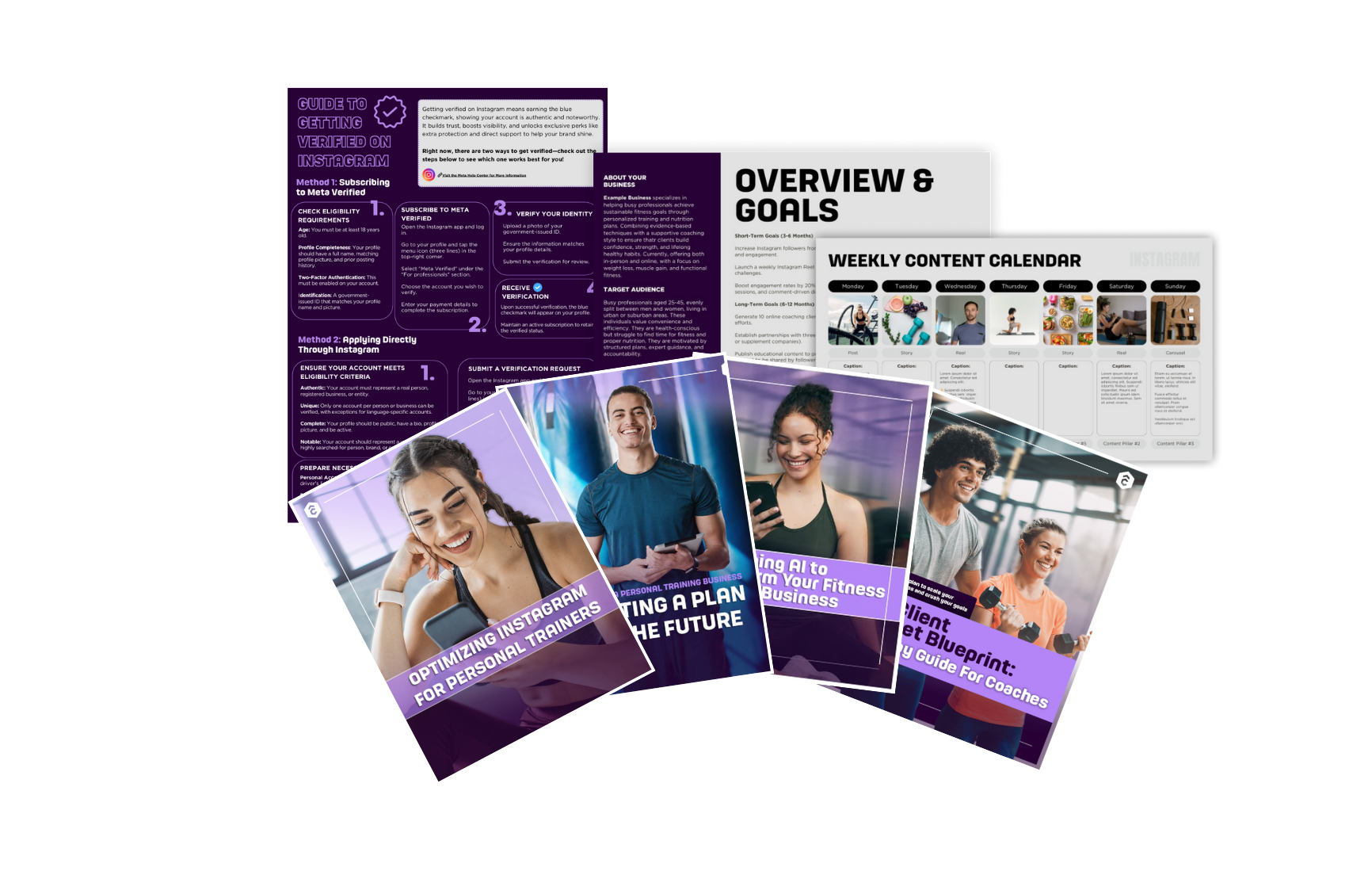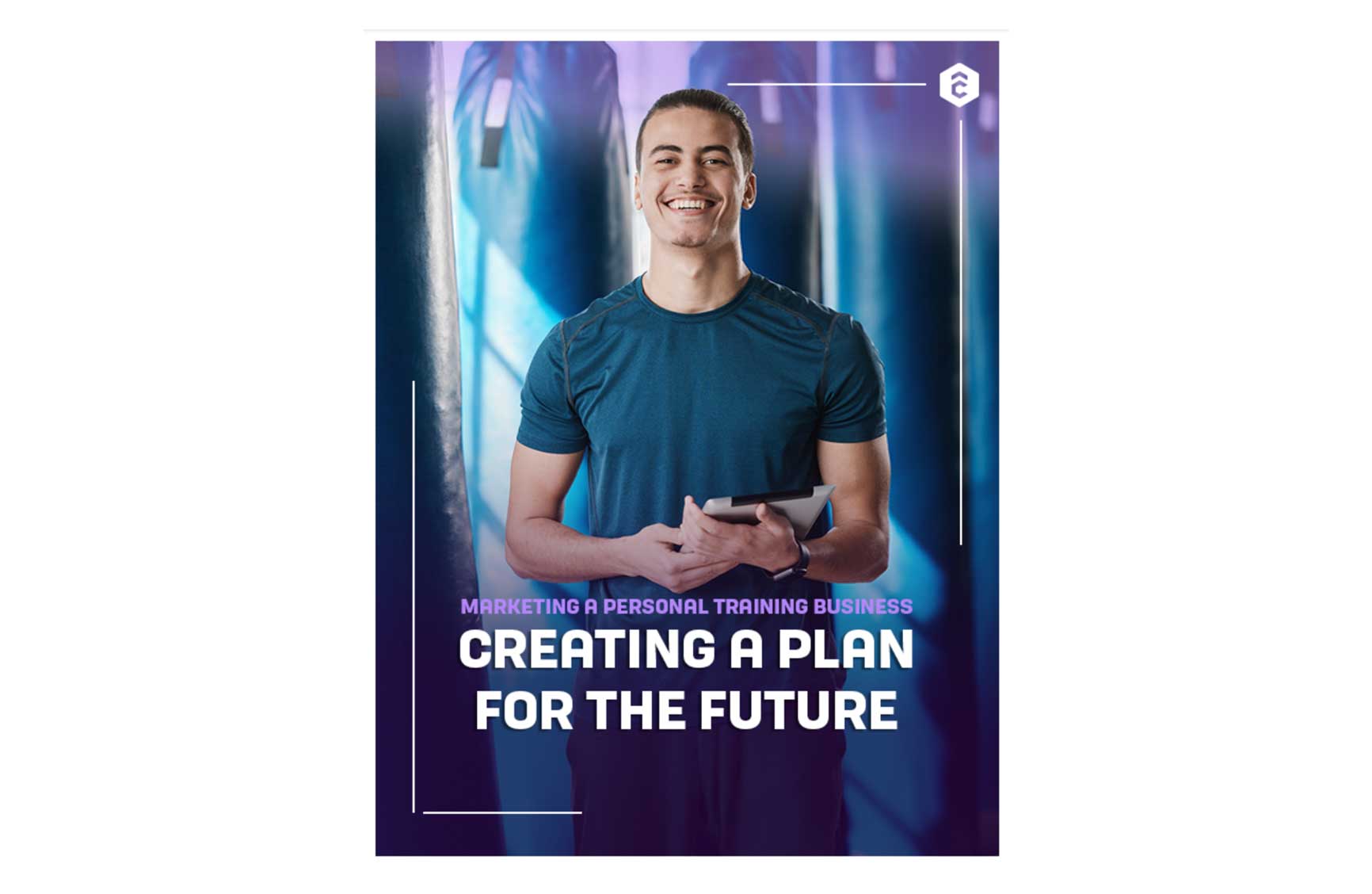The ghostly whisper in the classic 1989 film Field of Dreams was right. It was talking about a baseball field and we’re talking about compelling marketing content, but the message is the same: make it appealing, make it useful, and give them what they want.

You may already be regularly posting content, or maybe you’re wondering how to get started. Either way, every single piece of content that you release should work hard to drive client connections and help you achieve your business goals. You want to draw people in and make them eager to engage – be it through liking, sharing, reposting, or signing up as clients!
Read on for a brief guide to creating and publishing relevant content for the personal training market.
Who is your target audience?
Before you begin to plan and create content that will form an emotional connection with your audience you need to be sure you know exactly who that audience is!
Define your niche: Consider your own expertise and passion within the fitness industry. Are you a specialist in weight loss, strength training, or yoga? Identifying your niche will help you tailor your content to a more specific audience.
Identify key demographics: Determine the age range, gender, location, and other demographic details of your ideal clients. Different age groups and demographics may have varied fitness goals and preferences. Different groups also engage with social media differently. Older clients may be Facebook users while younger clients may prefer Tik Toks and Instagram posts.
Identify fitness goals: Whether it’s weight loss, muscle gain, flexibility, or general health and wellness, aligning your content with specific goals will attract the right audience.
Research competitors: Look at other personal trainers or fitness influencers who share a similar target audience. Analyze the kind of content they post, the engagement they receive, and learn from their strategies.
Create buyer personas: Develop detailed personas representing your ideal clients. Consider their motivations, pain points, preferences, and lifestyles. This exercise will help you tailor your content to meet the specific needs of your target audience.
Utilize analytics: Use social media analytics tools to understand the demographics and interests of your current followers. Platforms like Instagram and Facebook provide insights into your audience’s age, location, and engagement patterns.
Ask questions and encourage feedback: Engage with your audience by asking questions and encouraging them to share their thoughts and feedback. This can provide valuable information about their interests and preferences and also strengthen your relationship with them.
How can you connect with your target audience?
Once you’ve identified who your audience is and what their needs and pain points are, the next step (and sometimes the hardest) is coming up with engaging, interesting, share-worthy content that will resonate with them and ultimately drive traffic to your business. Remember, having a big following on social media is excellent, but the whole point is to attract more people to sign up with you.
It’s important to always consider the user experience (UX). A positive user experience can lead to increased engagement, brand loyalty, and overall success.
Build a brand 😎
The most important thing to keep in mind and use as the backbone of your content creation is brand awareness. You need to have your own brand identity that people will begin to recognise and associate with you. You may find it helpful to develop a brand kit and brand guide so that your branding remains consistent. These may consist of things like a logo, standard fonts and colors, company slogans or statements, headshots, etc.
Brand awareness helps to build trust in your business, and makes you look professional and successful. Want to know something else that’s awesome? With TrueCoach’s customization options (such as adding your logo, choosing colors, and creating a subdomain) you can brand your coaching business seamlessly.
You can also enhance your brand awareness by using a customizable coaching app that reflects your logo, colors, and business style, offering clients a seamless branded experience.
Make it visual 🎨
It’s important to find a balance here. Yes, you want something attractive enough to stop them scrolling, but you don’t want to constantly overwhelm people with heaps of bright images.
Enhance the appeal and impact of your posts by using a combination of photos, videos, and images with text overlay. It’s not like you need to make every post super visual. It’s best to track engagement on every kind of post you create so you can see what works and what doesn’t.
When you do include visual elements, make sure they are high quality, high resolution, and highly interesting! Real photos have also proven to be more appealing than stock photos, so don’t be afraid to get snapping (but always seek permission before posting pics of clients).
Use clever writing tools 🧠
Admittedly this doesn’t come easily to everyone, but using metaphors, analogies, and anecdotes can add depth and memorability to your social media content.
Metaphors make a direct comparison between two unrelated concepts and highlights their similarities. For example, you could choose a familiar metaphor that resonates with your message: “Building muscle is like growing a garden; it takes time, patience, and consistent effort to see results.”
Analogies draw parallels between two different things, emphasizing similarities to make complex ideas more relatable.
For example, you could simplify complex fitness concepts by comparing them to everyday activities: “Balancing your workout routine is like creating a well-balanced meal; you need a mix of different elements for optimal results.”
Anecdotes are short, personal stories that add a human touch to your content, making it more relatable. You could share personal fitness experiences or success stories: “I once struggled with consistency in my workouts, but when I started treating them like appointments, my fitness journey transformed.”
Keep it brief 😴
Few people these days have the time or attention span to read long posts, or watch long videos. Keep it brief, keep it snappy, keep it focused on the message you want to send.
Consider the story you want to tell and then be creative in telling that story as quickly as possible. You know the saying, ‘a picture is worth a thousand words’? How can you say a lot in a succinct way?

What types of content should you create?
Now this is where it gets exciting because you have so many options! Truly, the only limit is your imagination. The important thing to remember is WHY you’re creating the content: to increase your reach and drive people to your business.
That’s right, we’re talking about lead generation and the buyer’s journey. In other words, how to grab them by the eyeballs and then funnel them down an engaging, exciting, informative curly slide until they drop into your business as new clients.
This article has some great advice for creating compelling digital marketing content, including the advice that content should do one of these four things: educate, entertain, inspire, or promote.
Here are just a few things to consider.
Search engine optimization (SEO) 🔎
SEO (which is a crucial tool for marketers) is the process of making your website or online content more visible and attractive to search engines like Google. The goal is to improve your content’s ranking in search results when people use certain keywords or phrases.
For some great tips, check out this article: SEO Marketing Strategy: 8 Components of a Successful SEO Strategy in 2024
Social media marketing 🤳
This involves sharing content on social media sites such as Facebook, Instagram, X (formerly Twitter), YouTube, Pinterest, and LinkedIn. As we mentioned, the #1 goal with this is increasing recognition of your brand and driving customers to your business.
You could consider posting:
- Reels (short videos)
- Photos or collages
- Polls (e.g. Do you like to eat breakfast before a morning workout?)
- Instructional videos
- ‘Behind the scenes’ content
- Challenges, contests and comps
- Nutrition advice
- Reposted relevant content (can be humorous)
- Customer testimonials and success stories
- Informative infographics
- Industry news
We’ve got heaps of advice on making the most of social media. Check out our blog posts:
Instagram for personal trainers – 3 tips to upgrade your profile
How to use Instagram for personal trainers
How to use TikTok for personal trainers
How to use facebook for personal trainers
Content marketing 💻
Content marketing is about producing content that your target audience finds useful, entertaining, or informative. If your business has a website (which it should), this sort of content is perfect for it. It can take various forms, such as:
- blog posts
- ebooks
- articles
- videos
- infographics
No doubt you’re reading this blog post and thinking, ‘YES, amazing, I need one of these for my business’. Firstly, thanks if you were thinking that, and secondly, absolutely! A regular blog post can be a great way to educate, entertain, inspire, or promote (hopefully several at once). You can then keep linking back to these in your social media posts.
When writing your blogs, you don’t have to become Shakespeare, but it’s hard to engage with a piece of writing if it’s poorly constructed and lacks correct grammar and punctuation. If this is an area you struggle in there’s plenty of help available, from outsourcing to a copywriter or utilizing AI such as ChatGPT. Check out our blog on using ChatGPT to build your business.
Reusing content ♻
Don’t assume that every single piece of content you release needs to be brand new and original. Humans can be simple creatures sometimes and we like familiarity. Also, we’re not all online all the time, so we will miss things.
Go ahead and reuse content to keep it fresh in people’s minds. You could even put a slightly different spin on it or give it a different caption or image. If you notice a particular post gets a lot of engagement then definitely put that back out there in future!
Email marketing 📧
Email marketing involves sending targeted and personalized messages to a group of individuals via email. The primary goal is to nurture relationships with existing customers, build brand loyalty, and encourage customer engagement, as well as to acquire new customers or clients.
The benefits of email marketing include:
- It’s a much more direct and targeted way to communicate rather than relying on people catching social media posts.
- It can be automated to send scheduled, triggered, or behavior-based messages.
- Messages can be tailored to specific segments of the audience based on their preferences, behaviors, or past interactions with the brand. This personalization enhances the relevance of the content.
- The personal approach can help to build and strengthen relationships.
- You can use clear branding to build awareness.
- The performance of email campaigns can be tracked through metrics like open rates, click-through rates, and conversions. This data allows for analysis and optimization of future email marketing efforts.
- It’s easy to add call-to-actions (CTAs).
However you do need a mailing list to be able to send emails so you need to have strategies in place to gather email addresses whenever possible. Offering a free download (such as an informative ebook) is a great way to capture this information.
Create a content calendar 📅
Also known as an editorial calendar, a content calendar is a strategic planning tool used to organize, schedule, and manage content creation and publication across various channels. It serves as a roadmap to ensure a consistent and cohesive content strategy.
This will help you to plan your content in advance, meaning you will have full visibility and can ensure you have variety and can avoid repetition in any one area (for example, too much entertaining and not enough promotion).
This article provides advice and templates for putting together a content calendar.

How do you know if your content is compelling?
Put simply, if people are engaging with it, if that engagement is increasing, and if you’re gaining new clients, you can be confident you’re on the right track.
But we can get a bit more technical than that. Everything you put out should be tracked and measured to assess the success rate. You can then adjust your strategy accordingly.
Things you can track include:
Customer engagement metrics 👍
Track metrics like comments, shares, and reviews to measure audience engagement. This helps you to understand how well your content resonates with your audience and adjust your strategies based on audience feedback.
Website analytics 📈
Use tools like Google Analytics to track website metrics, including traffic, bounce rate, time on site, and conversion rates. Analyze which pages are popular, where visitors are coming from, and how they navigate through your site.
Social media analytics ❤
Each social platform provides analytics tools. Track metrics such as engagement (likes, comments, shares), reach, clicks, and follower growth. Identify which content performs best, understand audience demographics, and adjust strategies based on platform-specific data.
Email marketing metrics 📩
Monitor email open rates, click-through rates, conversion rates, and unsubscribe rates. Understand how well your emails resonate with your audience, which subject lines work best, and which calls-to-action drive the most conversions.
Conversion tracking ✔
Set up conversion tracking to monitor specific actions users take on your website, such as form submissions, purchases, or downloads. Evaluate the effectiveness of your campaigns in driving desired actions and optimize accordingly.
Search engine rankings 📊
Monitor your website’s position in search engine results for relevant keywords. Improvements in rankings indicate the effectiveness of your SEO efforts and can lead to increased organic traffic.
Get crafting!
Now that you know how important compelling content is for your business, there’s no time to waste. For more information download our free eBook: Marketing Your Personal Training Business
About TrueCoach
TrueCoach is the industry’s best workout builder that makes it easy for personal trainers and coaches to grow their business while delivering an exceptional experience for their clients. With its user-friendly interface and time-saving features, TrueCoach is the ideal choice for personal trainers looking to streamline their workflow.
Get Started With a
Free 14 Day Trial
Enter your email to try TrueCoach completely risk-free.
- No credit card required.
- Cancel any time.

Recommended Resources For You

Resource
Grow Your Business With Social Media
Author: Clare Hudson
Everything you need to take the guesswork out of social media. Start turning your followers into paying clients today.

Resource
Marketing Your Personal Training Business in 2025
Author: Clare Hudson
Marketing is one of the most critical tools for growing any business, but there’s no one size fits all strategy. Do you know how well your current strategy is doing? And what should you do to prepare for the new year?

Blog
5 Lies You Tell Yourself Why You Aren’t Creating And Sharing Content
Author: Andrew Coates
You’re holding back your thoughts and ideas. Your desire to create is stifled because you’re lying to yourself. These lies protect you from being vulnerable. You think they protect you from the judgement and criticism you fear if you put your work on display for the world to tear down. You’re also safe from being […]

Author: TrueCoach FRSA CSM
-
First published: January 15 2024
Written by: Bobby O'Connell

